Auckland Uni: Dissertation Literature Review on International Business
VerifiedAdded on 2021/04/24
|26
|11642
|100
Literature Review
AI Summary
This literature review examines the scholarly work on business firms' entry into foreign markets. It begins with an introduction and then reviews the Uppsala Model and OLI paradigm, foundational theories of internationalization. The review then explores Multinational Enterprise (MNE) entry into new national markets, factors affecting MNE performance, and the impacts on the host country. It also covers the age of competitive dynamics, online retail, and the challenges faced by local businesses. The document highlights the significance of market analysis and the evolution of competitive strategies in the context of international business expansion, while also acknowledging gaps in current research, particularly the competitive nature of international market entry.
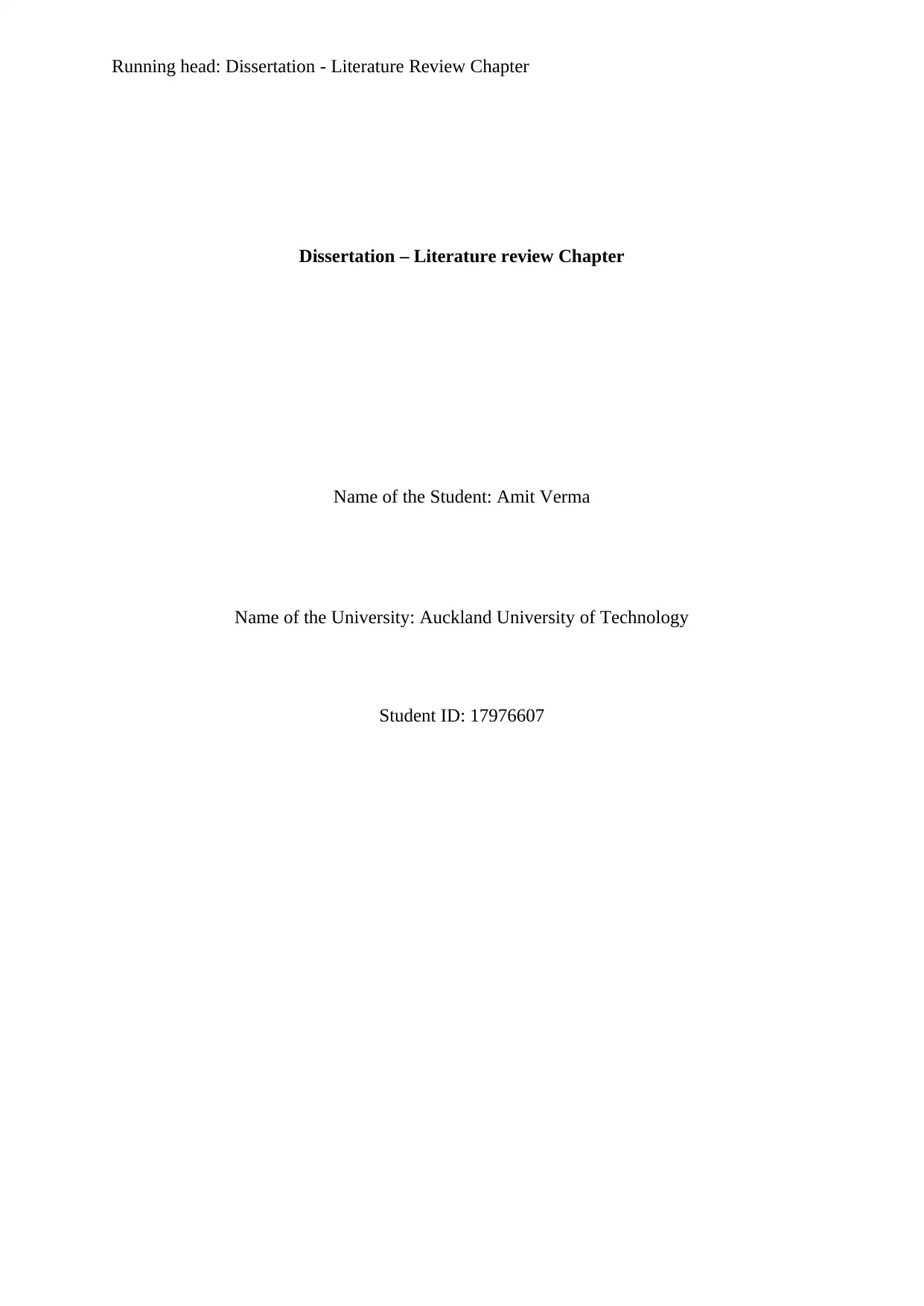
Running head: Dissertation - Literature Review Chapter
Dissertation – Literature review Chapter
Name of the Student: Amit Verma
Name of the University: Auckland University of Technology
Student ID: 17976607
Dissertation – Literature review Chapter
Name of the Student: Amit Verma
Name of the University: Auckland University of Technology
Student ID: 17976607
Paraphrase This Document
Need a fresh take? Get an instant paraphrase of this document with our AI Paraphraser
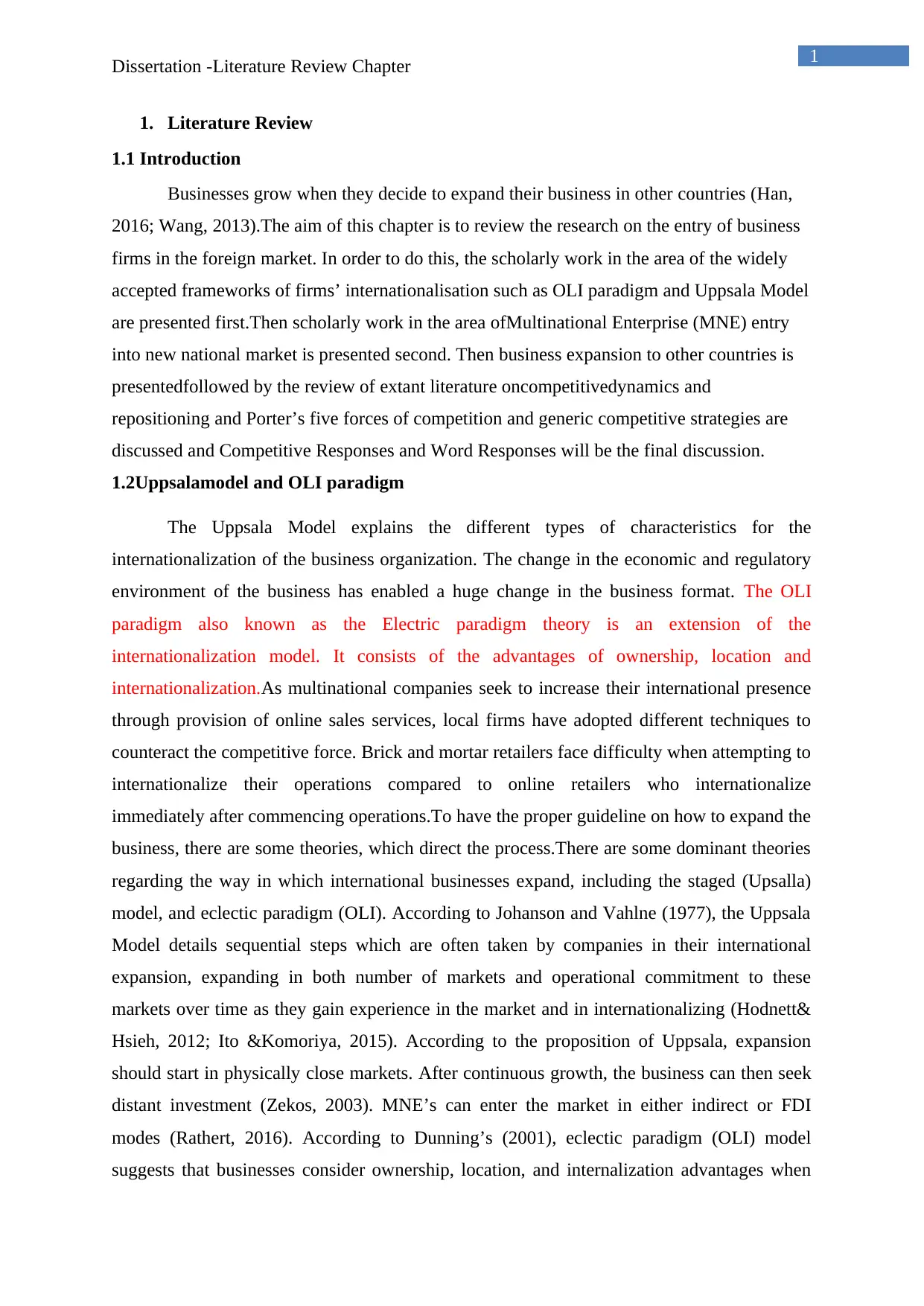
1
Dissertation -Literature Review Chapter
1. Literature Review
1.1 Introduction
Businesses grow when they decide to expand their business in other countries (Han,
2016; Wang, 2013).The aim of this chapter is to review the research on the entry of business
firms in the foreign market. In order to do this, the scholarly work in the area of the widely
accepted frameworks of firms’ internationalisation such as OLI paradigm and Uppsala Model
are presented first.Then scholarly work in the area ofMultinational Enterprise (MNE) entry
into new national market is presented second. Then business expansion to other countries is
presentedfollowed by the review of extant literature oncompetitivedynamics and
repositioning and Porter’s five forces of competition and generic competitive strategies are
discussed and Competitive Responses and Word Responses will be the final discussion.
1.2Uppsalamodel and OLI paradigm
The Uppsala Model explains the different types of characteristics for the
internationalization of the business organization. The change in the economic and regulatory
environment of the business has enabled a huge change in the business format. The OLI
paradigm also known as the Electric paradigm theory is an extension of the
internationalization model. It consists of the advantages of ownership, location and
internationalization.As multinational companies seek to increase their international presence
through provision of online sales services, local firms have adopted different techniques to
counteract the competitive force. Brick and mortar retailers face difficulty when attempting to
internationalize their operations compared to online retailers who internationalize
immediately after commencing operations.To have the proper guideline on how to expand the
business, there are some theories, which direct the process.There are some dominant theories
regarding the way in which international businesses expand, including the staged (Upsalla)
model, and eclectic paradigm (OLI). According to Johanson and Vahlne (1977), the Uppsala
Model details sequential steps which are often taken by companies in their international
expansion, expanding in both number of markets and operational commitment to these
markets over time as they gain experience in the market and in internationalizing (Hodnett&
Hsieh, 2012; Ito &Komoriya, 2015). According to the proposition of Uppsala, expansion
should start in physically close markets. After continuous growth, the business can then seek
distant investment (Zekos, 2003). MNE’s can enter the market in either indirect or FDI
modes (Rathert, 2016). According to Dunning’s (2001), eclectic paradigm (OLI) model
suggests that businesses consider ownership, location, and internalization advantages when
Dissertation -Literature Review Chapter
1. Literature Review
1.1 Introduction
Businesses grow when they decide to expand their business in other countries (Han,
2016; Wang, 2013).The aim of this chapter is to review the research on the entry of business
firms in the foreign market. In order to do this, the scholarly work in the area of the widely
accepted frameworks of firms’ internationalisation such as OLI paradigm and Uppsala Model
are presented first.Then scholarly work in the area ofMultinational Enterprise (MNE) entry
into new national market is presented second. Then business expansion to other countries is
presentedfollowed by the review of extant literature oncompetitivedynamics and
repositioning and Porter’s five forces of competition and generic competitive strategies are
discussed and Competitive Responses and Word Responses will be the final discussion.
1.2Uppsalamodel and OLI paradigm
The Uppsala Model explains the different types of characteristics for the
internationalization of the business organization. The change in the economic and regulatory
environment of the business has enabled a huge change in the business format. The OLI
paradigm also known as the Electric paradigm theory is an extension of the
internationalization model. It consists of the advantages of ownership, location and
internationalization.As multinational companies seek to increase their international presence
through provision of online sales services, local firms have adopted different techniques to
counteract the competitive force. Brick and mortar retailers face difficulty when attempting to
internationalize their operations compared to online retailers who internationalize
immediately after commencing operations.To have the proper guideline on how to expand the
business, there are some theories, which direct the process.There are some dominant theories
regarding the way in which international businesses expand, including the staged (Upsalla)
model, and eclectic paradigm (OLI). According to Johanson and Vahlne (1977), the Uppsala
Model details sequential steps which are often taken by companies in their international
expansion, expanding in both number of markets and operational commitment to these
markets over time as they gain experience in the market and in internationalizing (Hodnett&
Hsieh, 2012; Ito &Komoriya, 2015). According to the proposition of Uppsala, expansion
should start in physically close markets. After continuous growth, the business can then seek
distant investment (Zekos, 2003). MNE’s can enter the market in either indirect or FDI
modes (Rathert, 2016). According to Dunning’s (2001), eclectic paradigm (OLI) model
suggests that businesses consider ownership, location, and internalization advantages when
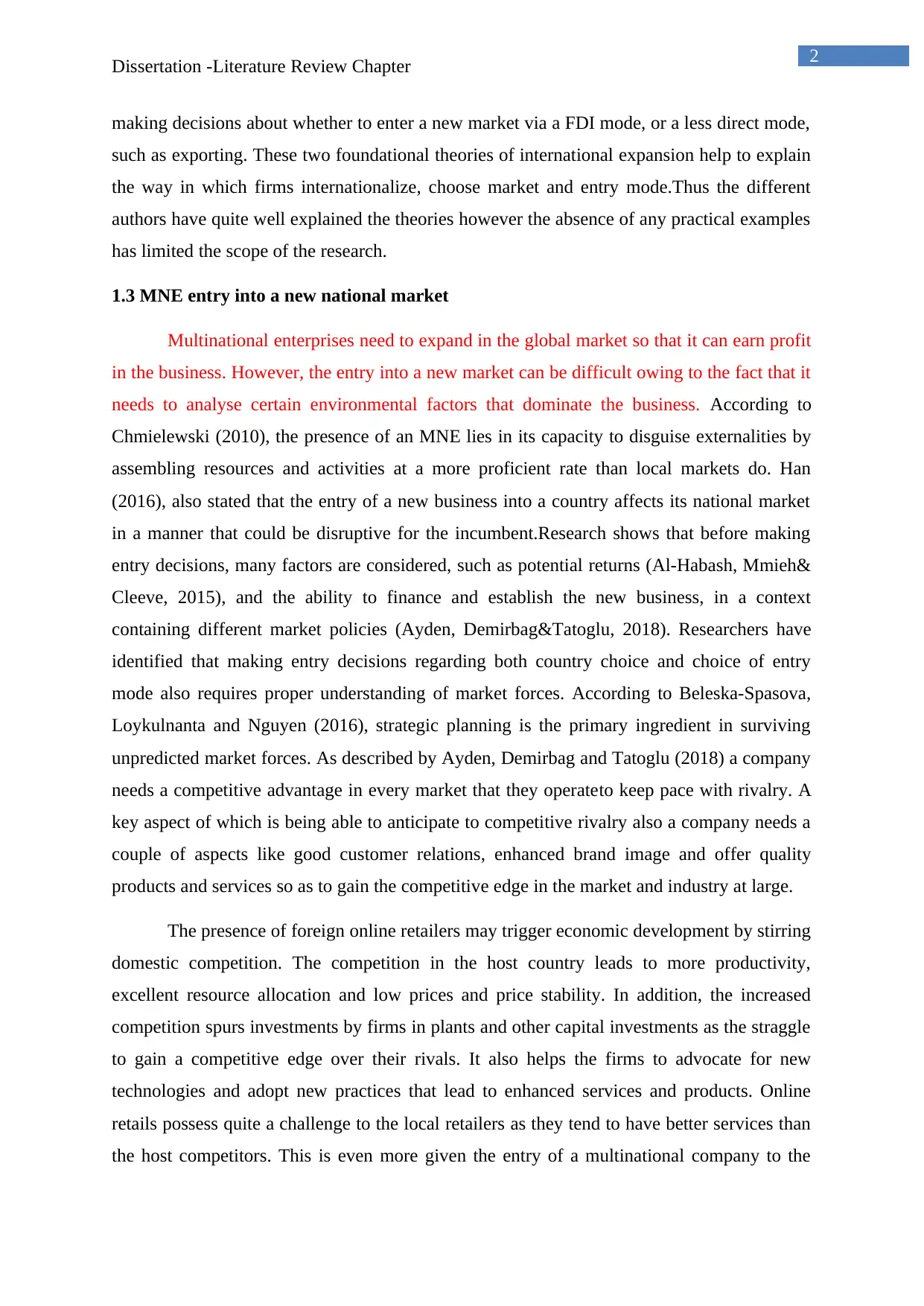
2
Dissertation -Literature Review Chapter
making decisions about whether to enter a new market via a FDI mode, or a less direct mode,
such as exporting. These two foundational theories of international expansion help to explain
the way in which firms internationalize, choose market and entry mode.Thus the different
authors have quite well explained the theories however the absence of any practical examples
has limited the scope of the research.
1.3 MNE entry into a new national market
Multinational enterprises need to expand in the global market so that it can earn profit
in the business. However, the entry into a new market can be difficult owing to the fact that it
needs to analyse certain environmental factors that dominate the business. According to
Chmielewski (2010), the presence of an MNE lies in its capacity to disguise externalities by
assembling resources and activities at a more proficient rate than local markets do. Han
(2016), also stated that the entry of a new business into a country affects its national market
in a manner that could be disruptive for the incumbent.Research shows that before making
entry decisions, many factors are considered, such as potential returns (Al-Habash, Mmieh&
Cleeve, 2015), and the ability to finance and establish the new business, in a context
containing different market policies (Ayden, Demirbag&Tatoglu, 2018). Researchers have
identified that making entry decisions regarding both country choice and choice of entry
mode also requires proper understanding of market forces. According to Beleska-Spasova,
Loykulnanta and Nguyen (2016), strategic planning is the primary ingredient in surviving
unpredicted market forces. As described by Ayden, Demirbag and Tatoglu (2018) a company
needs a competitive advantage in every market that they operateto keep pace with rivalry. A
key aspect of which is being able to anticipate to competitive rivalry also a company needs a
couple of aspects like good customer relations, enhanced brand image and offer quality
products and services so as to gain the competitive edge in the market and industry at large.
The presence of foreign online retailers may trigger economic development by stirring
domestic competition. The competition in the host country leads to more productivity,
excellent resource allocation and low prices and price stability. In addition, the increased
competition spurs investments by firms in plants and other capital investments as the straggle
to gain a competitive edge over their rivals. It also helps the firms to advocate for new
technologies and adopt new practices that lead to enhanced services and products. Online
retails possess quite a challenge to the local retailers as they tend to have better services than
the host competitors. This is even more given the entry of a multinational company to the
Dissertation -Literature Review Chapter
making decisions about whether to enter a new market via a FDI mode, or a less direct mode,
such as exporting. These two foundational theories of international expansion help to explain
the way in which firms internationalize, choose market and entry mode.Thus the different
authors have quite well explained the theories however the absence of any practical examples
has limited the scope of the research.
1.3 MNE entry into a new national market
Multinational enterprises need to expand in the global market so that it can earn profit
in the business. However, the entry into a new market can be difficult owing to the fact that it
needs to analyse certain environmental factors that dominate the business. According to
Chmielewski (2010), the presence of an MNE lies in its capacity to disguise externalities by
assembling resources and activities at a more proficient rate than local markets do. Han
(2016), also stated that the entry of a new business into a country affects its national market
in a manner that could be disruptive for the incumbent.Research shows that before making
entry decisions, many factors are considered, such as potential returns (Al-Habash, Mmieh&
Cleeve, 2015), and the ability to finance and establish the new business, in a context
containing different market policies (Ayden, Demirbag&Tatoglu, 2018). Researchers have
identified that making entry decisions regarding both country choice and choice of entry
mode also requires proper understanding of market forces. According to Beleska-Spasova,
Loykulnanta and Nguyen (2016), strategic planning is the primary ingredient in surviving
unpredicted market forces. As described by Ayden, Demirbag and Tatoglu (2018) a company
needs a competitive advantage in every market that they operateto keep pace with rivalry. A
key aspect of which is being able to anticipate to competitive rivalry also a company needs a
couple of aspects like good customer relations, enhanced brand image and offer quality
products and services so as to gain the competitive edge in the market and industry at large.
The presence of foreign online retailers may trigger economic development by stirring
domestic competition. The competition in the host country leads to more productivity,
excellent resource allocation and low prices and price stability. In addition, the increased
competition spurs investments by firms in plants and other capital investments as the straggle
to gain a competitive edge over their rivals. It also helps the firms to advocate for new
technologies and adopt new practices that lead to enhanced services and products. Online
retails possess quite a challenge to the local retailers as they tend to have better services than
the host competitors. This is even more given the entry of a multinational company to the
⊘ This is a preview!⊘
Do you want full access?
Subscribe today to unlock all pages.

Trusted by 1+ million students worldwide
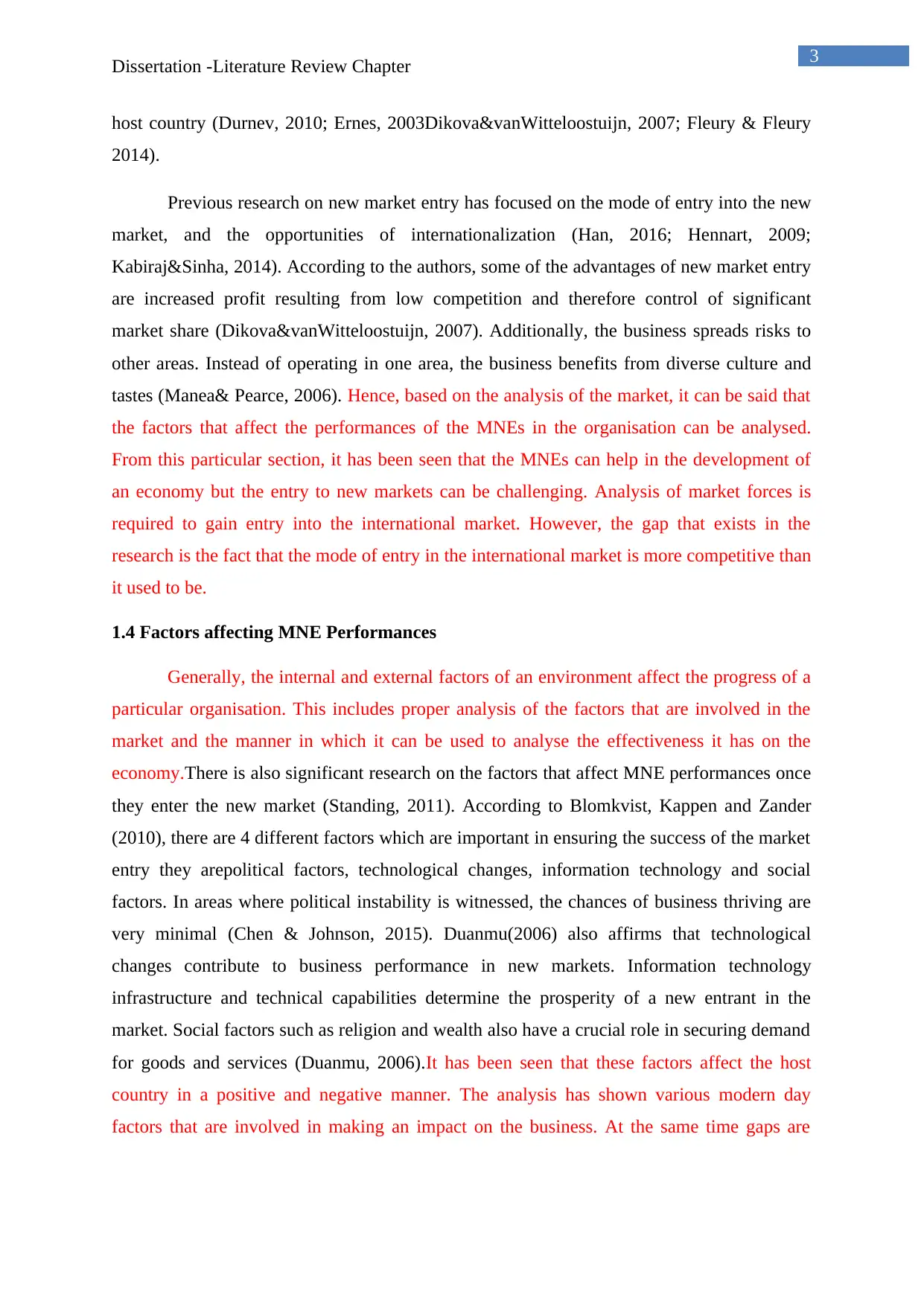
3
Dissertation -Literature Review Chapter
host country (Durnev, 2010; Ernes, 2003Dikova&vanWitteloostuijn, 2007; Fleury & Fleury
2014).
Previous research on new market entry has focused on the mode of entry into the new
market, and the opportunities of internationalization (Han, 2016; Hennart, 2009;
Kabiraj&Sinha, 2014). According to the authors, some of the advantages of new market entry
are increased profit resulting from low competition and therefore control of significant
market share (Dikova&vanWitteloostuijn, 2007). Additionally, the business spreads risks to
other areas. Instead of operating in one area, the business benefits from diverse culture and
tastes (Manea& Pearce, 2006). Hence, based on the analysis of the market, it can be said that
the factors that affect the performances of the MNEs in the organisation can be analysed.
From this particular section, it has been seen that the MNEs can help in the development of
an economy but the entry to new markets can be challenging. Analysis of market forces is
required to gain entry into the international market. However, the gap that exists in the
research is the fact that the mode of entry in the international market is more competitive than
it used to be.
1.4 Factors affecting MNE Performances
Generally, the internal and external factors of an environment affect the progress of a
particular organisation. This includes proper analysis of the factors that are involved in the
market and the manner in which it can be used to analyse the effectiveness it has on the
economy.There is also significant research on the factors that affect MNE performances once
they enter the new market (Standing, 2011). According to Blomkvist, Kappen and Zander
(2010), there are 4 different factors which are important in ensuring the success of the market
entry they arepolitical factors, technological changes, information technology and social
factors. In areas where political instability is witnessed, the chances of business thriving are
very minimal (Chen & Johnson, 2015). Duanmu(2006) also affirms that technological
changes contribute to business performance in new markets. Information technology
infrastructure and technical capabilities determine the prosperity of a new entrant in the
market. Social factors such as religion and wealth also have a crucial role in securing demand
for goods and services (Duanmu, 2006).It has been seen that these factors affect the host
country in a positive and negative manner. The analysis has shown various modern day
factors that are involved in making an impact on the business. At the same time gaps are
Dissertation -Literature Review Chapter
host country (Durnev, 2010; Ernes, 2003Dikova&vanWitteloostuijn, 2007; Fleury & Fleury
2014).
Previous research on new market entry has focused on the mode of entry into the new
market, and the opportunities of internationalization (Han, 2016; Hennart, 2009;
Kabiraj&Sinha, 2014). According to the authors, some of the advantages of new market entry
are increased profit resulting from low competition and therefore control of significant
market share (Dikova&vanWitteloostuijn, 2007). Additionally, the business spreads risks to
other areas. Instead of operating in one area, the business benefits from diverse culture and
tastes (Manea& Pearce, 2006). Hence, based on the analysis of the market, it can be said that
the factors that affect the performances of the MNEs in the organisation can be analysed.
From this particular section, it has been seen that the MNEs can help in the development of
an economy but the entry to new markets can be challenging. Analysis of market forces is
required to gain entry into the international market. However, the gap that exists in the
research is the fact that the mode of entry in the international market is more competitive than
it used to be.
1.4 Factors affecting MNE Performances
Generally, the internal and external factors of an environment affect the progress of a
particular organisation. This includes proper analysis of the factors that are involved in the
market and the manner in which it can be used to analyse the effectiveness it has on the
economy.There is also significant research on the factors that affect MNE performances once
they enter the new market (Standing, 2011). According to Blomkvist, Kappen and Zander
(2010), there are 4 different factors which are important in ensuring the success of the market
entry they arepolitical factors, technological changes, information technology and social
factors. In areas where political instability is witnessed, the chances of business thriving are
very minimal (Chen & Johnson, 2015). Duanmu(2006) also affirms that technological
changes contribute to business performance in new markets. Information technology
infrastructure and technical capabilities determine the prosperity of a new entrant in the
market. Social factors such as religion and wealth also have a crucial role in securing demand
for goods and services (Duanmu, 2006).It has been seen that these factors affect the host
country in a positive and negative manner. The analysis has shown various modern day
factors that are involved in making an impact on the business. At the same time gaps are
Paraphrase This Document
Need a fresh take? Get an instant paraphrase of this document with our AI Paraphraser

4
Dissertation -Literature Review Chapter
identified in the proper application of the factors that can help the organizations understand
the manner in which the internal factors also affect the business.
1.5 Impacts on Host Country
Every country needs to analyse the pros and cons that are involved with the existence
of MNC. In particular, the host country needs to adapt to the changes that are brought about
due to the existence of the organizations in the country. According to Brouthers (2013), entry
of an MNE into anew national market creates innovation and change in the
market.Theresearch carried out by Kabirajand Sinha (2014) stated the importance of MNEs
entering the new market, they further explained some of the advantages of MNE entering a
new national market. One the hostcountrybenefits from the skilled foreign labour. Second,
the host country benefits from the inflow of foreign capital, which MNE brings in. Third, the
host country can utilise its idle human and physical resources, whichcan results in the
increase in national income of the host country fourth, the entry of MNE could result the end
of local monopolies(Kabiraj& Sinha, 2014). New technologies are introduced in the country,
which is used to boost other sectors of the economy. Moreover, the new businesses create
employment, improving the living standards of the locals(Ernes, 2003). The government of
the host country collects more returns due to the high circulation of money in the
economy.Challenges are called forth by a new market entrant to a national condition. They
give government the benefits of taxes received and share a good stand in the economic
situation the country has at present. The analysis provides a systematic analysis of the
benefits that the host country may get with the introduction of new organisations. At the same
time, the culture of the country may change due to the urge of the people to buy and
implement recent trends in the society.
1.6 Age of Competitve Dynamics
In the modern world, every organisation wants to gain profit and recognition in the
market. The urge to gain control in the market keeps an organisation performing. This
competativeness is seen in organisations that are willing to establish itself in the international
market. The new entrant market is then driven to challenge incumbent market of their power
and capability in acquiring and achieving excellence in the economy the host country shared
with them(Ernes, 2003). According to Brouthers (2013), an MNE entry into a host country
could have a multi-layered impact on the host country's business. One example could be by
lowering the price of goods and services, which could create tough competition for the local
Dissertation -Literature Review Chapter
identified in the proper application of the factors that can help the organizations understand
the manner in which the internal factors also affect the business.
1.5 Impacts on Host Country
Every country needs to analyse the pros and cons that are involved with the existence
of MNC. In particular, the host country needs to adapt to the changes that are brought about
due to the existence of the organizations in the country. According to Brouthers (2013), entry
of an MNE into anew national market creates innovation and change in the
market.Theresearch carried out by Kabirajand Sinha (2014) stated the importance of MNEs
entering the new market, they further explained some of the advantages of MNE entering a
new national market. One the hostcountrybenefits from the skilled foreign labour. Second,
the host country benefits from the inflow of foreign capital, which MNE brings in. Third, the
host country can utilise its idle human and physical resources, whichcan results in the
increase in national income of the host country fourth, the entry of MNE could result the end
of local monopolies(Kabiraj& Sinha, 2014). New technologies are introduced in the country,
which is used to boost other sectors of the economy. Moreover, the new businesses create
employment, improving the living standards of the locals(Ernes, 2003). The government of
the host country collects more returns due to the high circulation of money in the
economy.Challenges are called forth by a new market entrant to a national condition. They
give government the benefits of taxes received and share a good stand in the economic
situation the country has at present. The analysis provides a systematic analysis of the
benefits that the host country may get with the introduction of new organisations. At the same
time, the culture of the country may change due to the urge of the people to buy and
implement recent trends in the society.
1.6 Age of Competitve Dynamics
In the modern world, every organisation wants to gain profit and recognition in the
market. The urge to gain control in the market keeps an organisation performing. This
competativeness is seen in organisations that are willing to establish itself in the international
market. The new entrant market is then driven to challenge incumbent market of their power
and capability in acquiring and achieving excellence in the economy the host country shared
with them(Ernes, 2003). According to Brouthers (2013), an MNE entry into a host country
could have a multi-layered impact on the host country's business. One example could be by
lowering the price of goods and services, which could create tough competition for the local
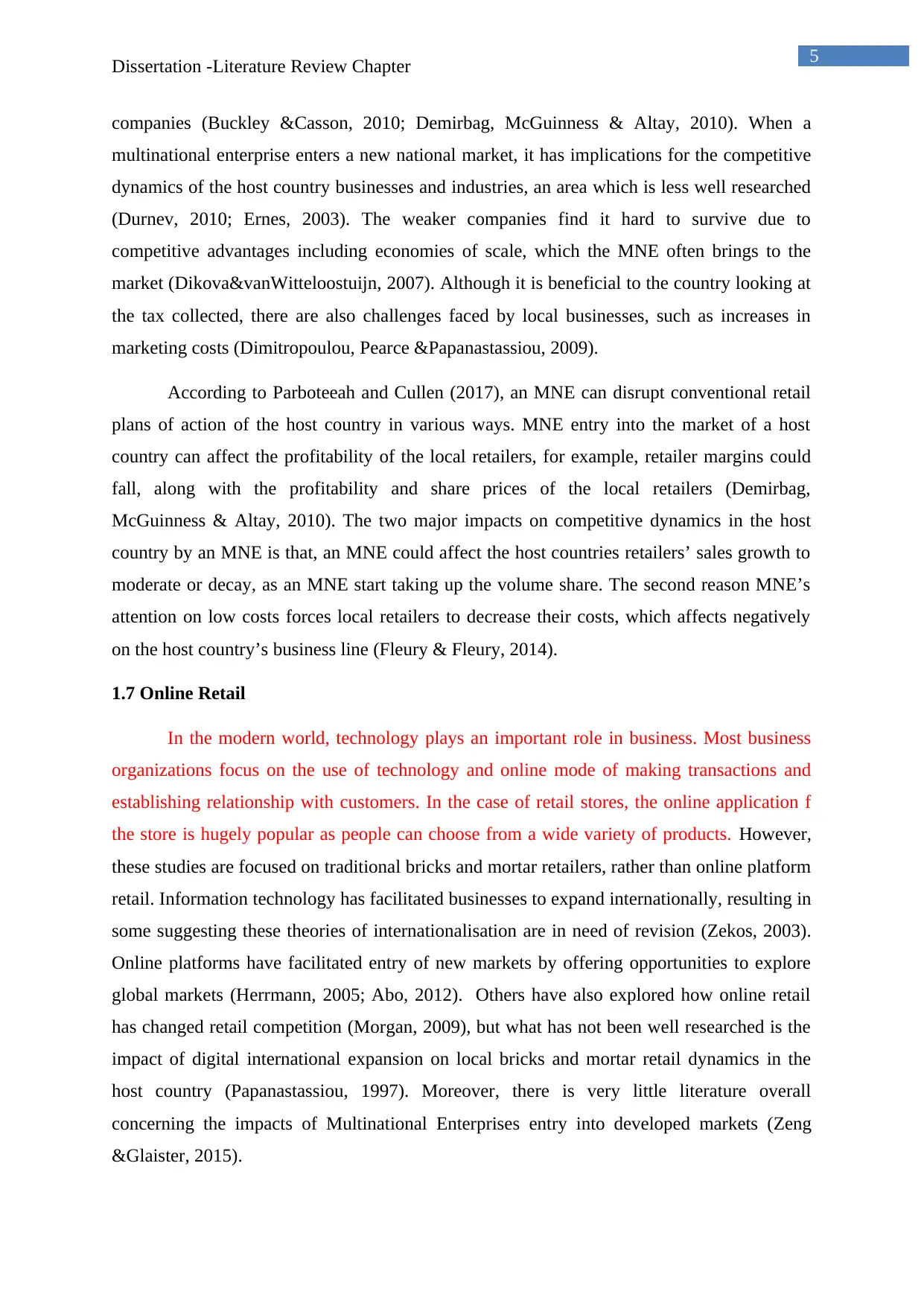
5
Dissertation -Literature Review Chapter
companies (Buckley &Casson, 2010; Demirbag, McGuinness & Altay, 2010). When a
multinational enterprise enters a new national market, it has implications for the competitive
dynamics of the host country businesses and industries, an area which is less well researched
(Durnev, 2010; Ernes, 2003). The weaker companies find it hard to survive due to
competitive advantages including economies of scale, which the MNE often brings to the
market (Dikova&vanWitteloostuijn, 2007). Although it is beneficial to the country looking at
the tax collected, there are also challenges faced by local businesses, such as increases in
marketing costs (Dimitropoulou, Pearce &Papanastassiou, 2009).
According to Parboteeah and Cullen (2017), an MNE can disrupt conventional retail
plans of action of the host country in various ways. MNE entry into the market of a host
country can affect the profitability of the local retailers, for example, retailer margins could
fall, along with the profitability and share prices of the local retailers (Demirbag,
McGuinness & Altay, 2010). The two major impacts on competitive dynamics in the host
country by an MNE is that, an MNE could affect the host countries retailers’ sales growth to
moderate or decay, as an MNE start taking up the volume share. The second reason MNE’s
attention on low costs forces local retailers to decrease their costs, which affects negatively
on the host country’s business line (Fleury & Fleury, 2014).
1.7 Online Retail
In the modern world, technology plays an important role in business. Most business
organizations focus on the use of technology and online mode of making transactions and
establishing relationship with customers. In the case of retail stores, the online application f
the store is hugely popular as people can choose from a wide variety of products. However,
these studies are focused on traditional bricks and mortar retailers, rather than online platform
retail. Information technology has facilitated businesses to expand internationally, resulting in
some suggesting these theories of internationalisation are in need of revision (Zekos, 2003).
Online platforms have facilitated entry of new markets by offering opportunities to explore
global markets (Herrmann, 2005; Abo, 2012). Others have also explored how online retail
has changed retail competition (Morgan, 2009), but what has not been well researched is the
impact of digital international expansion on local bricks and mortar retail dynamics in the
host country (Papanastassiou, 1997). Moreover, there is very little literature overall
concerning the impacts of Multinational Enterprises entry into developed markets (Zeng
&Glaister, 2015).
Dissertation -Literature Review Chapter
companies (Buckley &Casson, 2010; Demirbag, McGuinness & Altay, 2010). When a
multinational enterprise enters a new national market, it has implications for the competitive
dynamics of the host country businesses and industries, an area which is less well researched
(Durnev, 2010; Ernes, 2003). The weaker companies find it hard to survive due to
competitive advantages including economies of scale, which the MNE often brings to the
market (Dikova&vanWitteloostuijn, 2007). Although it is beneficial to the country looking at
the tax collected, there are also challenges faced by local businesses, such as increases in
marketing costs (Dimitropoulou, Pearce &Papanastassiou, 2009).
According to Parboteeah and Cullen (2017), an MNE can disrupt conventional retail
plans of action of the host country in various ways. MNE entry into the market of a host
country can affect the profitability of the local retailers, for example, retailer margins could
fall, along with the profitability and share prices of the local retailers (Demirbag,
McGuinness & Altay, 2010). The two major impacts on competitive dynamics in the host
country by an MNE is that, an MNE could affect the host countries retailers’ sales growth to
moderate or decay, as an MNE start taking up the volume share. The second reason MNE’s
attention on low costs forces local retailers to decrease their costs, which affects negatively
on the host country’s business line (Fleury & Fleury, 2014).
1.7 Online Retail
In the modern world, technology plays an important role in business. Most business
organizations focus on the use of technology and online mode of making transactions and
establishing relationship with customers. In the case of retail stores, the online application f
the store is hugely popular as people can choose from a wide variety of products. However,
these studies are focused on traditional bricks and mortar retailers, rather than online platform
retail. Information technology has facilitated businesses to expand internationally, resulting in
some suggesting these theories of internationalisation are in need of revision (Zekos, 2003).
Online platforms have facilitated entry of new markets by offering opportunities to explore
global markets (Herrmann, 2005; Abo, 2012). Others have also explored how online retail
has changed retail competition (Morgan, 2009), but what has not been well researched is the
impact of digital international expansion on local bricks and mortar retail dynamics in the
host country (Papanastassiou, 1997). Moreover, there is very little literature overall
concerning the impacts of Multinational Enterprises entry into developed markets (Zeng
&Glaister, 2015).
⊘ This is a preview!⊘
Do you want full access?
Subscribe today to unlock all pages.

Trusted by 1+ million students worldwide
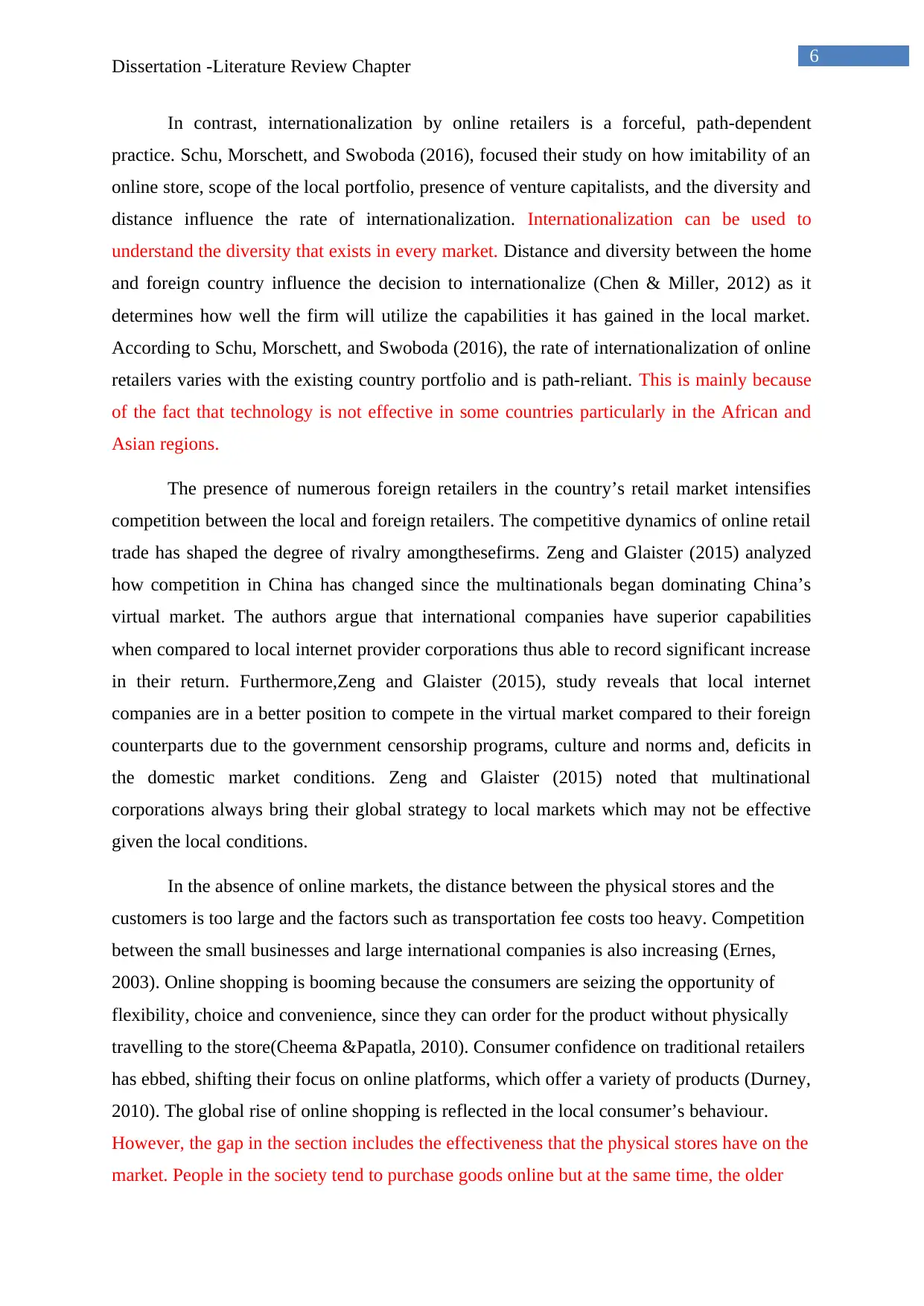
6
Dissertation -Literature Review Chapter
In contrast, internationalization by online retailers is a forceful, path-dependent
practice. Schu, Morschett, and Swoboda (2016), focused their study on how imitability of an
online store, scope of the local portfolio, presence of venture capitalists, and the diversity and
distance influence the rate of internationalization. Internationalization can be used to
understand the diversity that exists in every market. Distance and diversity between the home
and foreign country influence the decision to internationalize (Chen & Miller, 2012) as it
determines how well the firm will utilize the capabilities it has gained in the local market.
According to Schu, Morschett, and Swoboda (2016), the rate of internationalization of online
retailers varies with the existing country portfolio and is path-reliant. This is mainly because
of the fact that technology is not effective in some countries particularly in the African and
Asian regions.
The presence of numerous foreign retailers in the country’s retail market intensifies
competition between the local and foreign retailers. The competitive dynamics of online retail
trade has shaped the degree of rivalry amongthesefirms. Zeng and Glaister (2015) analyzed
how competition in China has changed since the multinationals began dominating China’s
virtual market. The authors argue that international companies have superior capabilities
when compared to local internet provider corporations thus able to record significant increase
in their return. Furthermore,Zeng and Glaister (2015), study reveals that local internet
companies are in a better position to compete in the virtual market compared to their foreign
counterparts due to the government censorship programs, culture and norms and, deficits in
the domestic market conditions. Zeng and Glaister (2015) noted that multinational
corporations always bring their global strategy to local markets which may not be effective
given the local conditions.
In the absence of online markets, the distance between the physical stores and the
customers is too large and the factors such as transportation fee costs too heavy. Competition
between the small businesses and large international companies is also increasing (Ernes,
2003). Online shopping is booming because the consumers are seizing the opportunity of
flexibility, choice and convenience, since they can order for the product without physically
travelling to the store(Cheema &Papatla, 2010). Consumer confidence on traditional retailers
has ebbed, shifting their focus on online platforms, which offer a variety of products (Durney,
2010). The global rise of online shopping is reflected in the local consumer’s behaviour.
However, the gap in the section includes the effectiveness that the physical stores have on the
market. People in the society tend to purchase goods online but at the same time, the older
Dissertation -Literature Review Chapter
In contrast, internationalization by online retailers is a forceful, path-dependent
practice. Schu, Morschett, and Swoboda (2016), focused their study on how imitability of an
online store, scope of the local portfolio, presence of venture capitalists, and the diversity and
distance influence the rate of internationalization. Internationalization can be used to
understand the diversity that exists in every market. Distance and diversity between the home
and foreign country influence the decision to internationalize (Chen & Miller, 2012) as it
determines how well the firm will utilize the capabilities it has gained in the local market.
According to Schu, Morschett, and Swoboda (2016), the rate of internationalization of online
retailers varies with the existing country portfolio and is path-reliant. This is mainly because
of the fact that technology is not effective in some countries particularly in the African and
Asian regions.
The presence of numerous foreign retailers in the country’s retail market intensifies
competition between the local and foreign retailers. The competitive dynamics of online retail
trade has shaped the degree of rivalry amongthesefirms. Zeng and Glaister (2015) analyzed
how competition in China has changed since the multinationals began dominating China’s
virtual market. The authors argue that international companies have superior capabilities
when compared to local internet provider corporations thus able to record significant increase
in their return. Furthermore,Zeng and Glaister (2015), study reveals that local internet
companies are in a better position to compete in the virtual market compared to their foreign
counterparts due to the government censorship programs, culture and norms and, deficits in
the domestic market conditions. Zeng and Glaister (2015) noted that multinational
corporations always bring their global strategy to local markets which may not be effective
given the local conditions.
In the absence of online markets, the distance between the physical stores and the
customers is too large and the factors such as transportation fee costs too heavy. Competition
between the small businesses and large international companies is also increasing (Ernes,
2003). Online shopping is booming because the consumers are seizing the opportunity of
flexibility, choice and convenience, since they can order for the product without physically
travelling to the store(Cheema &Papatla, 2010). Consumer confidence on traditional retailers
has ebbed, shifting their focus on online platforms, which offer a variety of products (Durney,
2010). The global rise of online shopping is reflected in the local consumer’s behaviour.
However, the gap in the section includes the effectiveness that the physical stores have on the
market. People in the society tend to purchase goods online but at the same time, the older
Paraphrase This Document
Need a fresh take? Get an instant paraphrase of this document with our AI Paraphraser
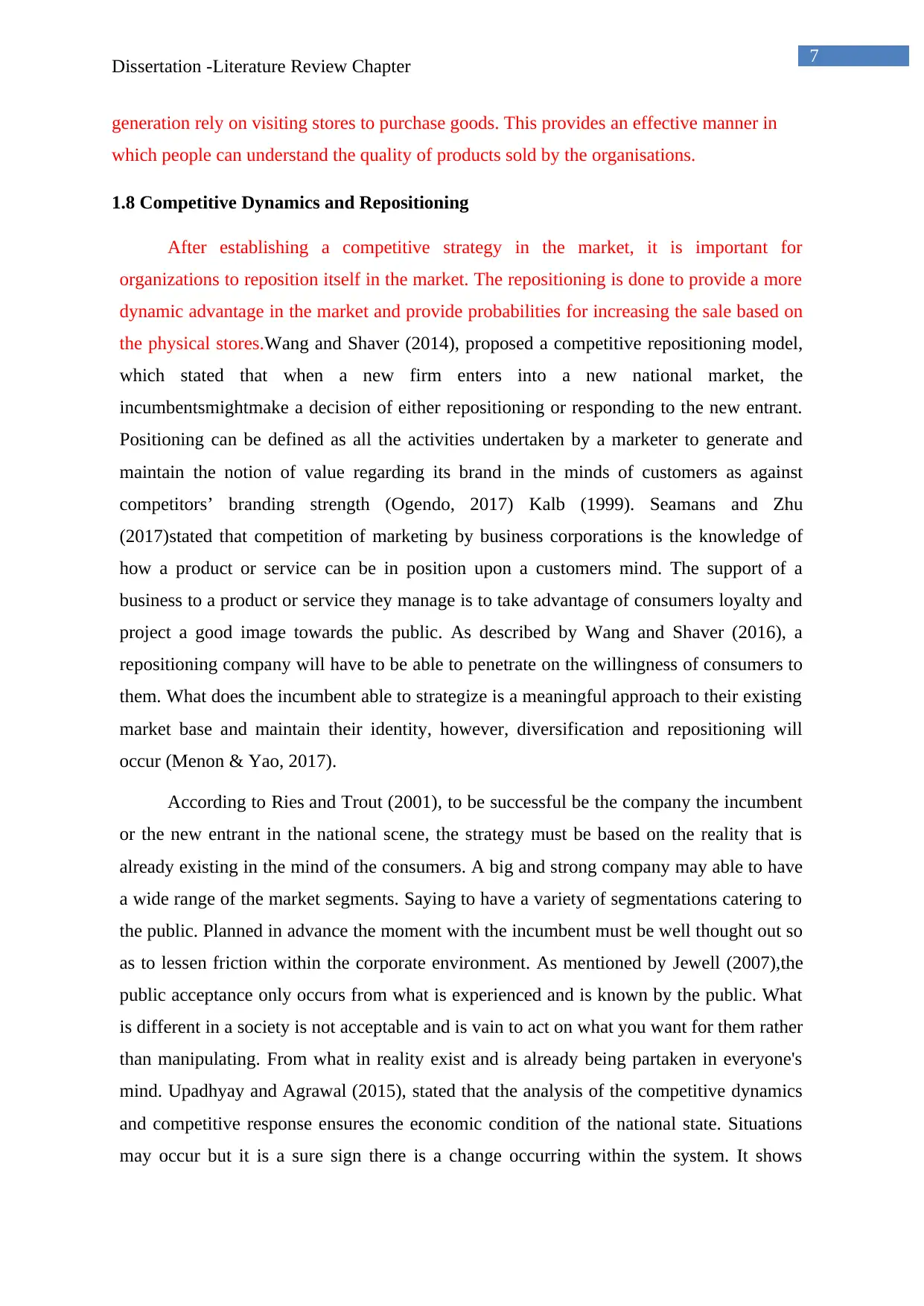
7
Dissertation -Literature Review Chapter
generation rely on visiting stores to purchase goods. This provides an effective manner in
which people can understand the quality of products sold by the organisations.
1.8 Competitive Dynamics and Repositioning
After establishing a competitive strategy in the market, it is important for
organizations to reposition itself in the market. The repositioning is done to provide a more
dynamic advantage in the market and provide probabilities for increasing the sale based on
the physical stores.Wang and Shaver (2014), proposed a competitive repositioning model,
which stated that when a new firm enters into a new national market, the
incumbentsmightmake a decision of either repositioning or responding to the new entrant.
Positioning can be defined as all the activities undertaken by a marketer to generate and
maintain the notion of value regarding its brand in the minds of customers as against
competitors’ branding strength (Ogendo, 2017) Kalb (1999). Seamans and Zhu
(2017)stated that competition of marketing by business corporations is the knowledge of
how a product or service can be in position upon a customers mind. The support of a
business to a product or service they manage is to take advantage of consumers loyalty and
project a good image towards the public. As described by Wang and Shaver (2016), a
repositioning company will have to be able to penetrate on the willingness of consumers to
them. What does the incumbent able to strategize is a meaningful approach to their existing
market base and maintain their identity, however, diversification and repositioning will
occur (Menon & Yao, 2017).
According to Ries and Trout (2001), to be successful be the company the incumbent
or the new entrant in the national scene, the strategy must be based on the reality that is
already existing in the mind of the consumers. A big and strong company may able to have
a wide range of the market segments. Saying to have a variety of segmentations catering to
the public. Planned in advance the moment with the incumbent must be well thought out so
as to lessen friction within the corporate environment. As mentioned by Jewell (2007),the
public acceptance only occurs from what is experienced and is known by the public. What
is different in a society is not acceptable and is vain to act on what you want for them rather
than manipulating. From what in reality exist and is already being partaken in everyone's
mind. Upadhyay and Agrawal (2015), stated that the analysis of the competitive dynamics
and competitive response ensures the economic condition of the national state. Situations
may occur but it is a sure sign there is a change occurring within the system. It shows
Dissertation -Literature Review Chapter
generation rely on visiting stores to purchase goods. This provides an effective manner in
which people can understand the quality of products sold by the organisations.
1.8 Competitive Dynamics and Repositioning
After establishing a competitive strategy in the market, it is important for
organizations to reposition itself in the market. The repositioning is done to provide a more
dynamic advantage in the market and provide probabilities for increasing the sale based on
the physical stores.Wang and Shaver (2014), proposed a competitive repositioning model,
which stated that when a new firm enters into a new national market, the
incumbentsmightmake a decision of either repositioning or responding to the new entrant.
Positioning can be defined as all the activities undertaken by a marketer to generate and
maintain the notion of value regarding its brand in the minds of customers as against
competitors’ branding strength (Ogendo, 2017) Kalb (1999). Seamans and Zhu
(2017)stated that competition of marketing by business corporations is the knowledge of
how a product or service can be in position upon a customers mind. The support of a
business to a product or service they manage is to take advantage of consumers loyalty and
project a good image towards the public. As described by Wang and Shaver (2016), a
repositioning company will have to be able to penetrate on the willingness of consumers to
them. What does the incumbent able to strategize is a meaningful approach to their existing
market base and maintain their identity, however, diversification and repositioning will
occur (Menon & Yao, 2017).
According to Ries and Trout (2001), to be successful be the company the incumbent
or the new entrant in the national scene, the strategy must be based on the reality that is
already existing in the mind of the consumers. A big and strong company may able to have
a wide range of the market segments. Saying to have a variety of segmentations catering to
the public. Planned in advance the moment with the incumbent must be well thought out so
as to lessen friction within the corporate environment. As mentioned by Jewell (2007),the
public acceptance only occurs from what is experienced and is known by the public. What
is different in a society is not acceptable and is vain to act on what you want for them rather
than manipulating. From what in reality exist and is already being partaken in everyone's
mind. Upadhyay and Agrawal (2015), stated that the analysis of the competitive dynamics
and competitive response ensures the economic condition of the national state. Situations
may occur but it is a sure sign there is a change occurring within the system. It shows
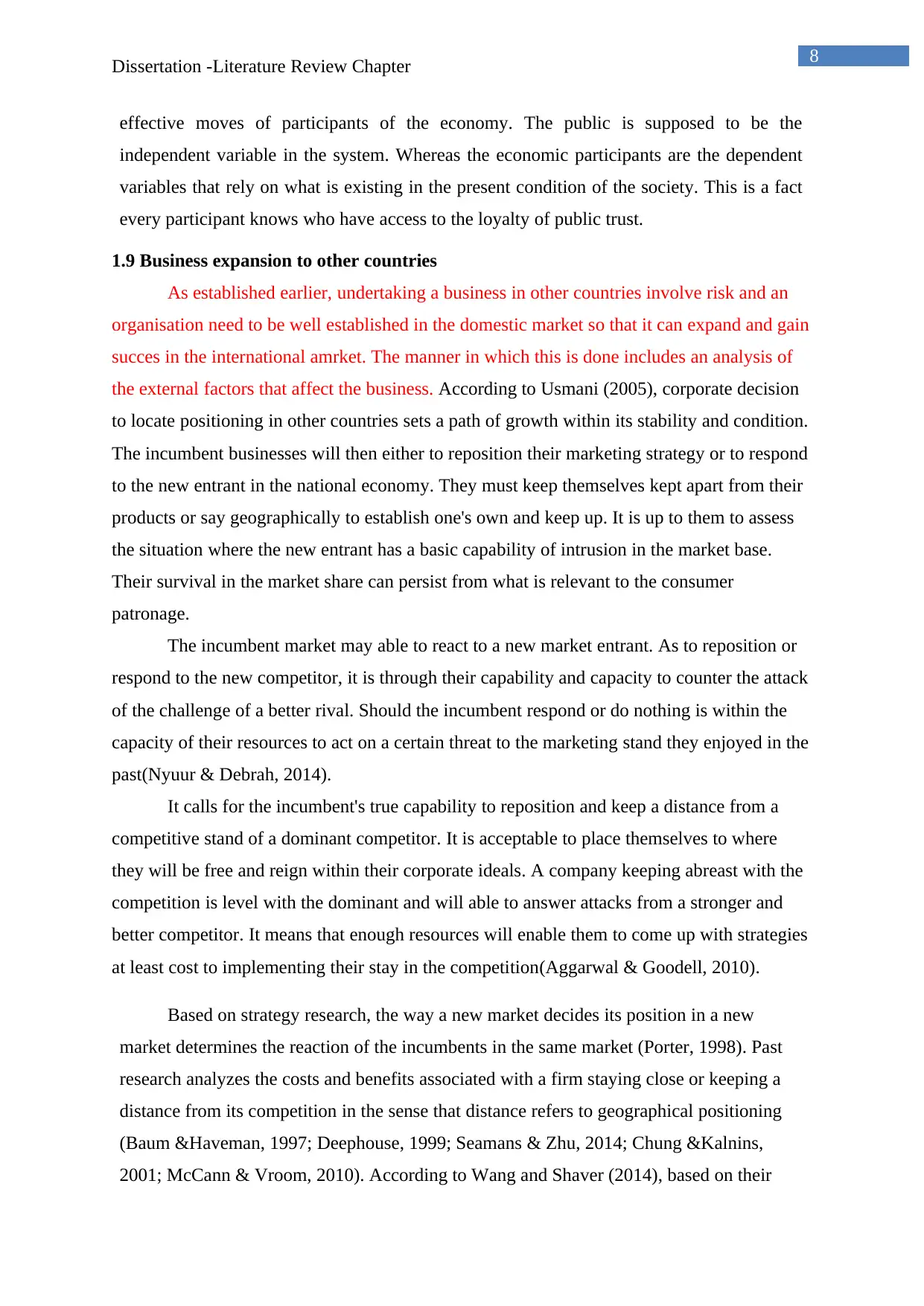
8
Dissertation -Literature Review Chapter
effective moves of participants of the economy. The public is supposed to be the
independent variable in the system. Whereas the economic participants are the dependent
variables that rely on what is existing in the present condition of the society. This is a fact
every participant knows who have access to the loyalty of public trust.
1.9 Business expansion to other countries
As established earlier, undertaking a business in other countries involve risk and an
organisation need to be well established in the domestic market so that it can expand and gain
succes in the international amrket. The manner in which this is done includes an analysis of
the external factors that affect the business. According to Usmani (2005), corporate decision
to locate positioning in other countries sets a path of growth within its stability and condition.
The incumbent businesses will then either to reposition their marketing strategy or to respond
to the new entrant in the national economy. They must keep themselves kept apart from their
products or say geographically to establish one's own and keep up. It is up to them to assess
the situation where the new entrant has a basic capability of intrusion in the market base.
Their survival in the market share can persist from what is relevant to the consumer
patronage.
The incumbent market may able to react to a new market entrant. As to reposition or
respond to the new competitor, it is through their capability and capacity to counter the attack
of the challenge of a better rival. Should the incumbent respond or do nothing is within the
capacity of their resources to act on a certain threat to the marketing stand they enjoyed in the
past(Nyuur & Debrah, 2014).
It calls for the incumbent's true capability to reposition and keep a distance from a
competitive stand of a dominant competitor. It is acceptable to place themselves to where
they will be free and reign within their corporate ideals. A company keeping abreast with the
competition is level with the dominant and will able to answer attacks from a stronger and
better competitor. It means that enough resources will enable them to come up with strategies
at least cost to implementing their stay in the competition(Aggarwal & Goodell, 2010).
Based on strategy research, the way a new market decides its position in a new
market determines the reaction of the incumbents in the same market (Porter, 1998). Past
research analyzes the costs and benefits associated with a firm staying close or keeping a
distance from its competition in the sense that distance refers to geographical positioning
(Baum &Haveman, 1997; Deephouse, 1999; Seamans & Zhu, 2014; Chung &Kalnins,
2001; McCann & Vroom, 2010). According to Wang and Shaver (2014), based on their
Dissertation -Literature Review Chapter
effective moves of participants of the economy. The public is supposed to be the
independent variable in the system. Whereas the economic participants are the dependent
variables that rely on what is existing in the present condition of the society. This is a fact
every participant knows who have access to the loyalty of public trust.
1.9 Business expansion to other countries
As established earlier, undertaking a business in other countries involve risk and an
organisation need to be well established in the domestic market so that it can expand and gain
succes in the international amrket. The manner in which this is done includes an analysis of
the external factors that affect the business. According to Usmani (2005), corporate decision
to locate positioning in other countries sets a path of growth within its stability and condition.
The incumbent businesses will then either to reposition their marketing strategy or to respond
to the new entrant in the national economy. They must keep themselves kept apart from their
products or say geographically to establish one's own and keep up. It is up to them to assess
the situation where the new entrant has a basic capability of intrusion in the market base.
Their survival in the market share can persist from what is relevant to the consumer
patronage.
The incumbent market may able to react to a new market entrant. As to reposition or
respond to the new competitor, it is through their capability and capacity to counter the attack
of the challenge of a better rival. Should the incumbent respond or do nothing is within the
capacity of their resources to act on a certain threat to the marketing stand they enjoyed in the
past(Nyuur & Debrah, 2014).
It calls for the incumbent's true capability to reposition and keep a distance from a
competitive stand of a dominant competitor. It is acceptable to place themselves to where
they will be free and reign within their corporate ideals. A company keeping abreast with the
competition is level with the dominant and will able to answer attacks from a stronger and
better competitor. It means that enough resources will enable them to come up with strategies
at least cost to implementing their stay in the competition(Aggarwal & Goodell, 2010).
Based on strategy research, the way a new market decides its position in a new
market determines the reaction of the incumbents in the same market (Porter, 1998). Past
research analyzes the costs and benefits associated with a firm staying close or keeping a
distance from its competition in the sense that distance refers to geographical positioning
(Baum &Haveman, 1997; Deephouse, 1999; Seamans & Zhu, 2014; Chung &Kalnins,
2001; McCann & Vroom, 2010). According to Wang and Shaver (2014), based on their
⊘ This is a preview!⊘
Do you want full access?
Subscribe today to unlock all pages.

Trusted by 1+ million students worldwide
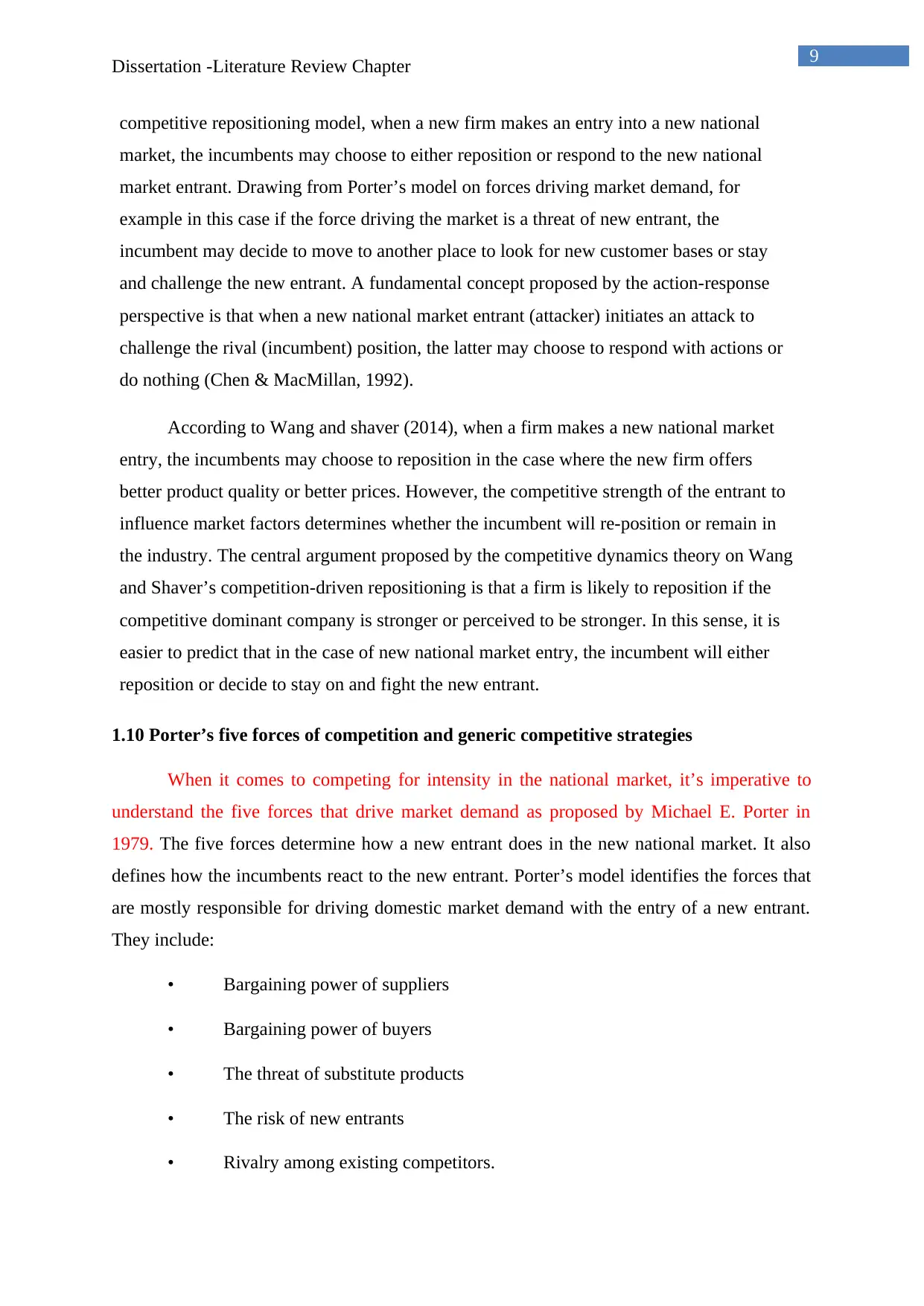
9
Dissertation -Literature Review Chapter
competitive repositioning model, when a new firm makes an entry into a new national
market, the incumbents may choose to either reposition or respond to the new national
market entrant. Drawing from Porter’s model on forces driving market demand, for
example in this case if the force driving the market is a threat of new entrant, the
incumbent may decide to move to another place to look for new customer bases or stay
and challenge the new entrant. A fundamental concept proposed by the action-response
perspective is that when a new national market entrant (attacker) initiates an attack to
challenge the rival (incumbent) position, the latter may choose to respond with actions or
do nothing (Chen & MacMillan, 1992).
According to Wang and shaver (2014), when a firm makes a new national market
entry, the incumbents may choose to reposition in the case where the new firm offers
better product quality or better prices. However, the competitive strength of the entrant to
influence market factors determines whether the incumbent will re-position or remain in
the industry. The central argument proposed by the competitive dynamics theory on Wang
and Shaver’s competition-driven repositioning is that a firm is likely to reposition if the
competitive dominant company is stronger or perceived to be stronger. In this sense, it is
easier to predict that in the case of new national market entry, the incumbent will either
reposition or decide to stay on and fight the new entrant.
1.10 Porter’s five forces of competition and generic competitive strategies
When it comes to competing for intensity in the national market, it’s imperative to
understand the five forces that drive market demand as proposed by Michael E. Porter in
1979. The five forces determine how a new entrant does in the new national market. It also
defines how the incumbents react to the new entrant. Porter’s model identifies the forces that
are mostly responsible for driving domestic market demand with the entry of a new entrant.
They include:
• Bargaining power of suppliers
• Bargaining power of buyers
• The threat of substitute products
• The risk of new entrants
• Rivalry among existing competitors.
Dissertation -Literature Review Chapter
competitive repositioning model, when a new firm makes an entry into a new national
market, the incumbents may choose to either reposition or respond to the new national
market entrant. Drawing from Porter’s model on forces driving market demand, for
example in this case if the force driving the market is a threat of new entrant, the
incumbent may decide to move to another place to look for new customer bases or stay
and challenge the new entrant. A fundamental concept proposed by the action-response
perspective is that when a new national market entrant (attacker) initiates an attack to
challenge the rival (incumbent) position, the latter may choose to respond with actions or
do nothing (Chen & MacMillan, 1992).
According to Wang and shaver (2014), when a firm makes a new national market
entry, the incumbents may choose to reposition in the case where the new firm offers
better product quality or better prices. However, the competitive strength of the entrant to
influence market factors determines whether the incumbent will re-position or remain in
the industry. The central argument proposed by the competitive dynamics theory on Wang
and Shaver’s competition-driven repositioning is that a firm is likely to reposition if the
competitive dominant company is stronger or perceived to be stronger. In this sense, it is
easier to predict that in the case of new national market entry, the incumbent will either
reposition or decide to stay on and fight the new entrant.
1.10 Porter’s five forces of competition and generic competitive strategies
When it comes to competing for intensity in the national market, it’s imperative to
understand the five forces that drive market demand as proposed by Michael E. Porter in
1979. The five forces determine how a new entrant does in the new national market. It also
defines how the incumbents react to the new entrant. Porter’s model identifies the forces that
are mostly responsible for driving domestic market demand with the entry of a new entrant.
They include:
• Bargaining power of suppliers
• Bargaining power of buyers
• The threat of substitute products
• The risk of new entrants
• Rivalry among existing competitors.
Paraphrase This Document
Need a fresh take? Get an instant paraphrase of this document with our AI Paraphraser
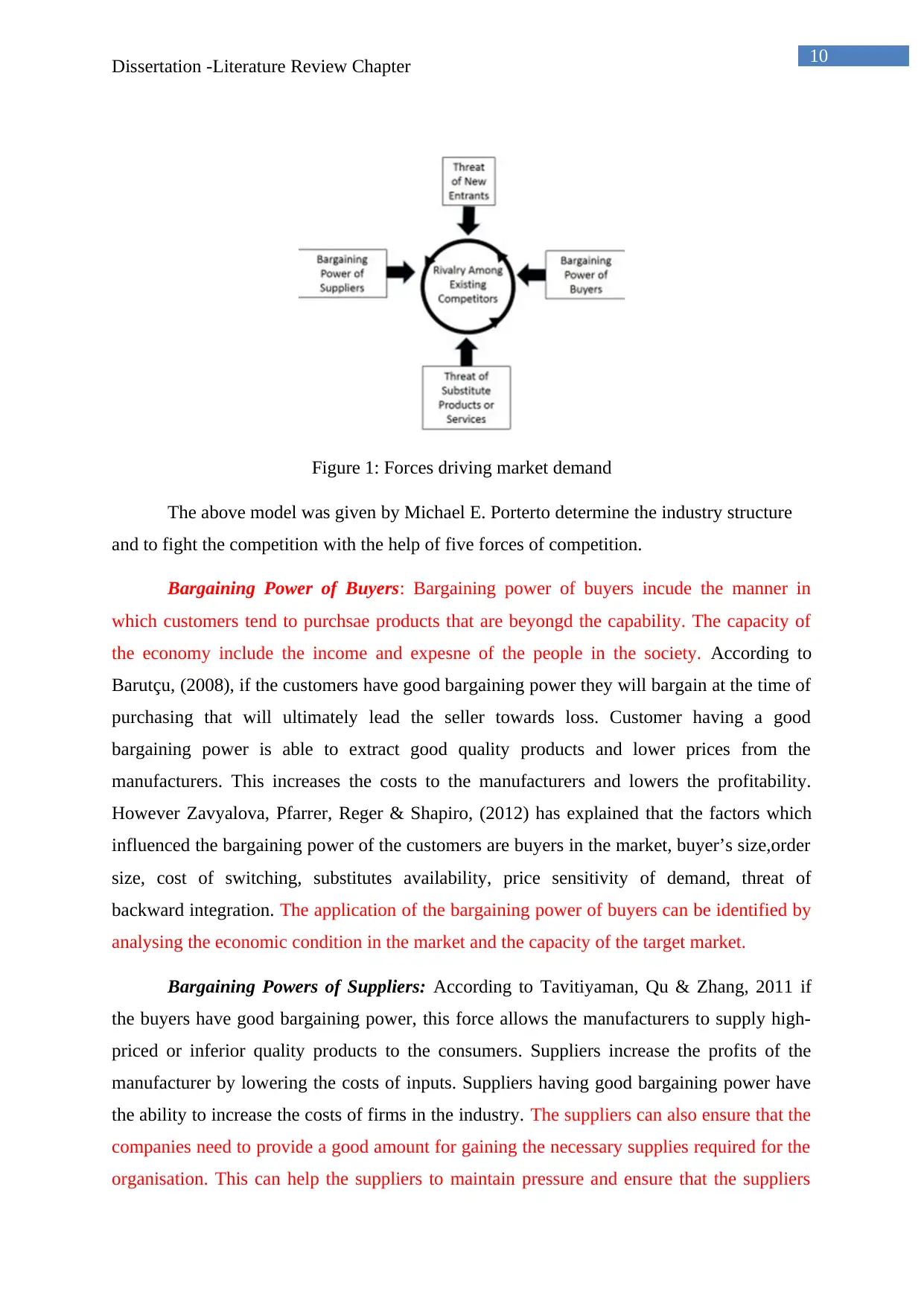
10
Dissertation -Literature Review Chapter
Figure 1: Forces driving market demand
The above model was given by Michael E. Porterto determine the industry structure
and to fight the competition with the help of five forces of competition.
Bargaining Power of Buyers: Bargaining power of buyers incude the manner in
which customers tend to purchsae products that are beyongd the capability. The capacity of
the economy include the income and expesne of the people in the society. According to
Barutçu, (2008), if the customers have good bargaining power they will bargain at the time of
purchasing that will ultimately lead the seller towards loss. Customer having a good
bargaining power is able to extract good quality products and lower prices from the
manufacturers. This increases the costs to the manufacturers and lowers the profitability.
However Zavyalova, Pfarrer, Reger & Shapiro, (2012) has explained that the factors which
influenced the bargaining power of the customers are buyers in the market, buyer’s size,order
size, cost of switching, substitutes availability, price sensitivity of demand, threat of
backward integration. The application of the bargaining power of buyers can be identified by
analysing the economic condition in the market and the capacity of the target market.
Bargaining Powers of Suppliers: According to Tavitiyaman, Qu & Zhang, 2011 if
the buyers have good bargaining power, this force allows the manufacturers to supply high-
priced or inferior quality products to the consumers. Suppliers increase the profits of the
manufacturer by lowering the costs of inputs. Suppliers having good bargaining power have
the ability to increase the costs of firms in the industry. The suppliers can also ensure that the
companies need to provide a good amount for gaining the necessary supplies required for the
organisation. This can help the suppliers to maintain pressure and ensure that the suppliers
Dissertation -Literature Review Chapter
Figure 1: Forces driving market demand
The above model was given by Michael E. Porterto determine the industry structure
and to fight the competition with the help of five forces of competition.
Bargaining Power of Buyers: Bargaining power of buyers incude the manner in
which customers tend to purchsae products that are beyongd the capability. The capacity of
the economy include the income and expesne of the people in the society. According to
Barutçu, (2008), if the customers have good bargaining power they will bargain at the time of
purchasing that will ultimately lead the seller towards loss. Customer having a good
bargaining power is able to extract good quality products and lower prices from the
manufacturers. This increases the costs to the manufacturers and lowers the profitability.
However Zavyalova, Pfarrer, Reger & Shapiro, (2012) has explained that the factors which
influenced the bargaining power of the customers are buyers in the market, buyer’s size,order
size, cost of switching, substitutes availability, price sensitivity of demand, threat of
backward integration. The application of the bargaining power of buyers can be identified by
analysing the economic condition in the market and the capacity of the target market.
Bargaining Powers of Suppliers: According to Tavitiyaman, Qu & Zhang, 2011 if
the buyers have good bargaining power, this force allows the manufacturers to supply high-
priced or inferior quality products to the consumers. Suppliers increase the profits of the
manufacturer by lowering the costs of inputs. Suppliers having good bargaining power have
the ability to increase the costs of firms in the industry. The suppliers can also ensure that the
companies need to provide a good amount for gaining the necessary supplies required for the
organisation. This can help the suppliers to maintain pressure and ensure that the suppliers
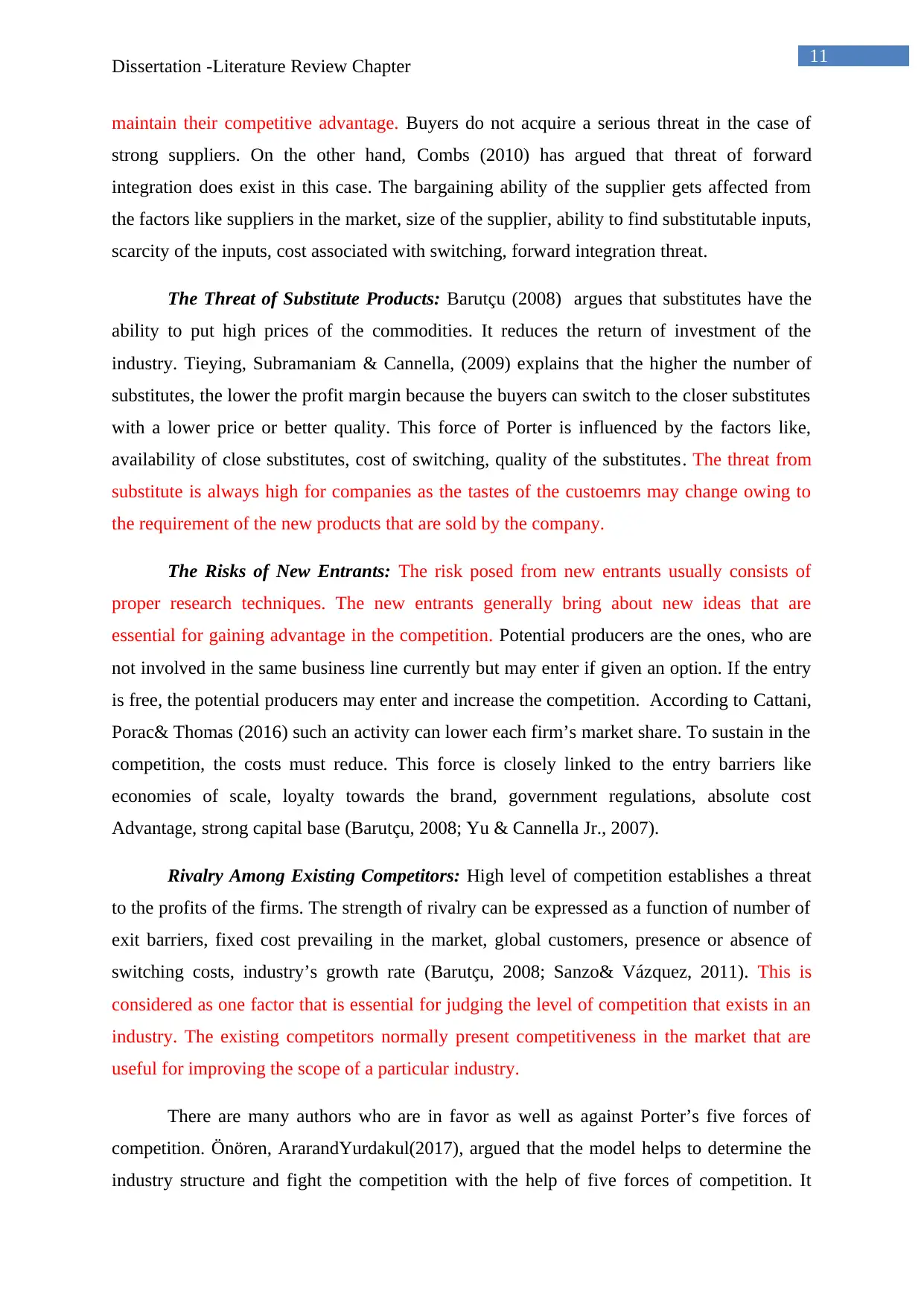
11
Dissertation -Literature Review Chapter
maintain their competitive advantage. Buyers do not acquire a serious threat in the case of
strong suppliers. On the other hand, Combs (2010) has argued that threat of forward
integration does exist in this case. The bargaining ability of the supplier gets affected from
the factors like suppliers in the market, size of the supplier, ability to find substitutable inputs,
scarcity of the inputs, cost associated with switching, forward integration threat.
The Threat of Substitute Products: Barutçu (2008) argues that substitutes have the
ability to put high prices of the commodities. It reduces the return of investment of the
industry. Tieying, Subramaniam & Cannella, (2009) explains that the higher the number of
substitutes, the lower the profit margin because the buyers can switch to the closer substitutes
with a lower price or better quality. This force of Porter is influenced by the factors like,
availability of close substitutes, cost of switching, quality of the substitutes. The threat from
substitute is always high for companies as the tastes of the custoemrs may change owing to
the requirement of the new products that are sold by the company.
The Risks of New Entrants: The risk posed from new entrants usually consists of
proper research techniques. The new entrants generally bring about new ideas that are
essential for gaining advantage in the competition. Potential producers are the ones, who are
not involved in the same business line currently but may enter if given an option. If the entry
is free, the potential producers may enter and increase the competition. According to Cattani,
Porac& Thomas (2016) such an activity can lower each firm’s market share. To sustain in the
competition, the costs must reduce. This force is closely linked to the entry barriers like
economies of scale, loyalty towards the brand, government regulations, absolute cost
Advantage, strong capital base (Barutçu, 2008; Yu & Cannella Jr., 2007).
Rivalry Among Existing Competitors: High level of competition establishes a threat
to the profits of the firms. The strength of rivalry can be expressed as a function of number of
exit barriers, fixed cost prevailing in the market, global customers, presence or absence of
switching costs, industry’s growth rate (Barutçu, 2008; Sanzo& Vázquez, 2011). This is
considered as one factor that is essential for judging the level of competition that exists in an
industry. The existing competitors normally present competitiveness in the market that are
useful for improving the scope of a particular industry.
There are many authors who are in favor as well as against Porter’s five forces of
competition. Önören, ArarandYurdakul(2017), argued that the model helps to determine the
industry structure and fight the competition with the help of five forces of competition. It
Dissertation -Literature Review Chapter
maintain their competitive advantage. Buyers do not acquire a serious threat in the case of
strong suppliers. On the other hand, Combs (2010) has argued that threat of forward
integration does exist in this case. The bargaining ability of the supplier gets affected from
the factors like suppliers in the market, size of the supplier, ability to find substitutable inputs,
scarcity of the inputs, cost associated with switching, forward integration threat.
The Threat of Substitute Products: Barutçu (2008) argues that substitutes have the
ability to put high prices of the commodities. It reduces the return of investment of the
industry. Tieying, Subramaniam & Cannella, (2009) explains that the higher the number of
substitutes, the lower the profit margin because the buyers can switch to the closer substitutes
with a lower price or better quality. This force of Porter is influenced by the factors like,
availability of close substitutes, cost of switching, quality of the substitutes. The threat from
substitute is always high for companies as the tastes of the custoemrs may change owing to
the requirement of the new products that are sold by the company.
The Risks of New Entrants: The risk posed from new entrants usually consists of
proper research techniques. The new entrants generally bring about new ideas that are
essential for gaining advantage in the competition. Potential producers are the ones, who are
not involved in the same business line currently but may enter if given an option. If the entry
is free, the potential producers may enter and increase the competition. According to Cattani,
Porac& Thomas (2016) such an activity can lower each firm’s market share. To sustain in the
competition, the costs must reduce. This force is closely linked to the entry barriers like
economies of scale, loyalty towards the brand, government regulations, absolute cost
Advantage, strong capital base (Barutçu, 2008; Yu & Cannella Jr., 2007).
Rivalry Among Existing Competitors: High level of competition establishes a threat
to the profits of the firms. The strength of rivalry can be expressed as a function of number of
exit barriers, fixed cost prevailing in the market, global customers, presence or absence of
switching costs, industry’s growth rate (Barutçu, 2008; Sanzo& Vázquez, 2011). This is
considered as one factor that is essential for judging the level of competition that exists in an
industry. The existing competitors normally present competitiveness in the market that are
useful for improving the scope of a particular industry.
There are many authors who are in favor as well as against Porter’s five forces of
competition. Önören, ArarandYurdakul(2017), argued that the model helps to determine the
industry structure and fight the competition with the help of five forces of competition. It
⊘ This is a preview!⊘
Do you want full access?
Subscribe today to unlock all pages.

Trusted by 1+ million students worldwide
1 out of 26